The Custard apple or Sugar apple (Annona squamosa) is one of the most commonly grown Annona trees. It is unknown exactly where Custard apples come from, but they are commonly grown in tropical South America, southern Mexico, the West Indies, the Bahamas, and Bermuda. The cultivation of this plant is most extensive in India and is extremely popular in Brazil’s interior. North Queensland, Australia, Jamaica, Puerto Rico, and Barbados are drier regions where it can grow wild.
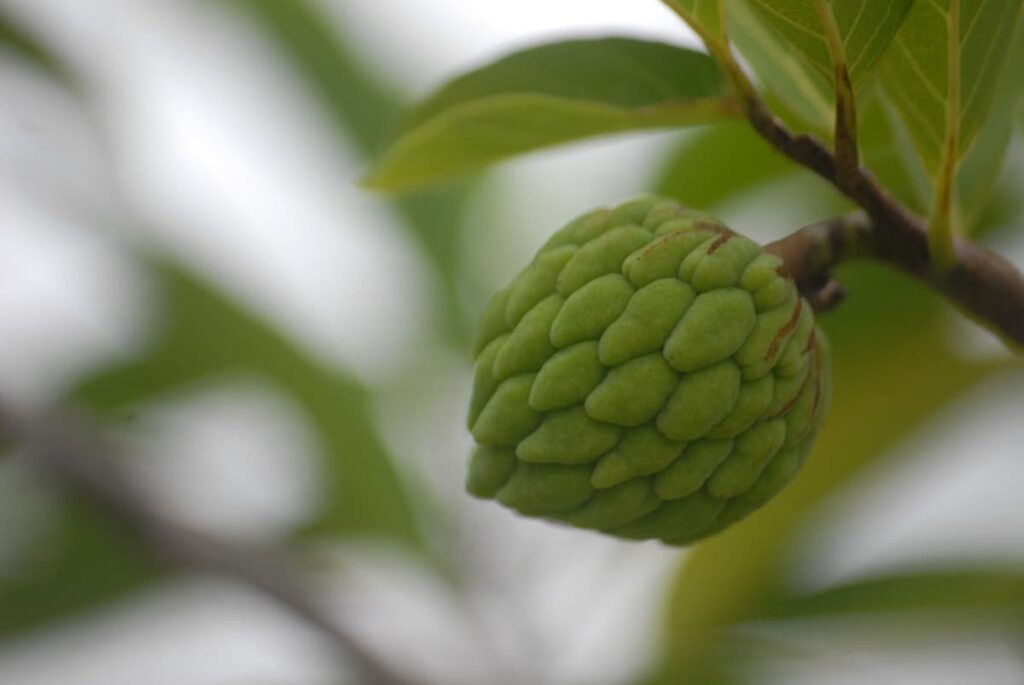
They have many names, including sweetsop, Custard apple, and scaly apple. The Custard apple tree can grow to a height of 10-20 feet (3-6 meters) and has irregular, zigzagging twigs. The foliage looks dull green on top, and pale green is on the bottom. A crushed leaf has an aromatic scent, like fragrant flowers, which can be single or grouped. They have long drooping stalks, a yellow-green exterior, and a pale yellow interior.
How to Grow custard apple in pots
Best Custard apple varieties
It varies in shape and color, from spherical to conical, with knobby segments on the thick rind. The color of Custard apple fruit varies from pale green through blue to green. It is quite easy to separate the fruit segments when lightly pressed between hands when the fruit is ripe, exposing the flesh inside.
It is named Custard apple because of the creamy texture of its flesh. Some Custard apple fruits are small in size and contain many seeds. Alternatively, some Custard apples produce large fruits with 5-7 seeds and all flesh. Listed below are three main Custard apple varieties.
Pink Mammoth Custard apple
In addition to its common name, it is also called the Hilary White Custard apple. Fruits can weigh up to 3kg and have very few seeds, almost seedless. In the commercial production of Custard apples, it is the most common variety.
Cuban seedless Custard apple
One of the essential cultivars is the Seedless Cuban. Fruits are medium-sized and slightly malformed, with some undeveloped seeds present. Although the flavor is less appealing, the fruit is more productive.
In case you missed it: Plant Growth Regulators in Agriculture and Horticulture: How to Use for Higher Yields and Benefits
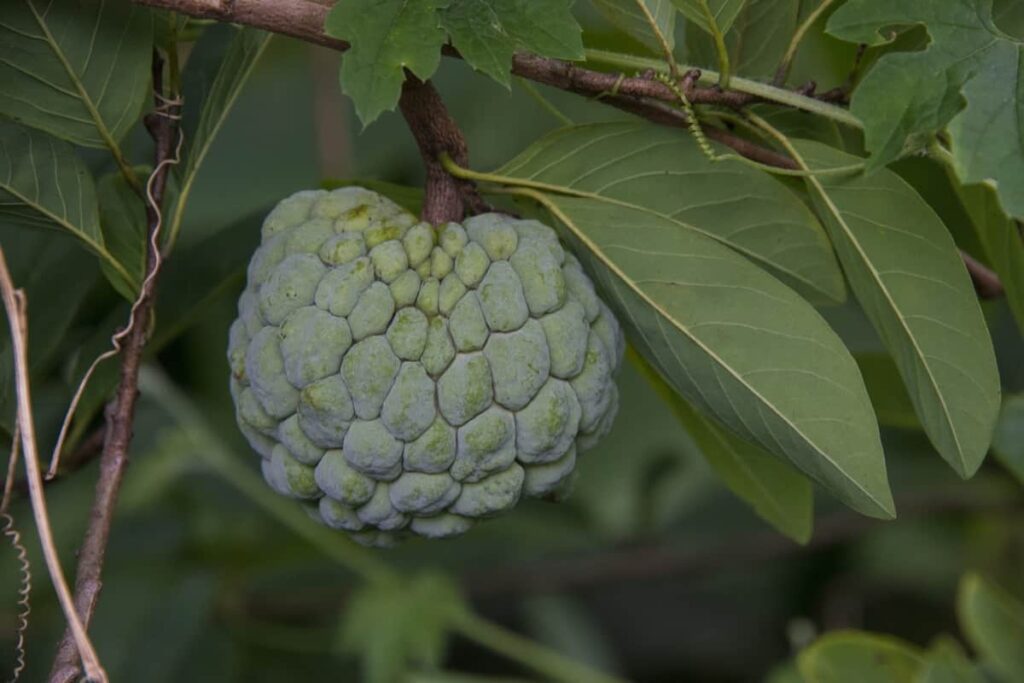
African Pride Custard apple
Compared to the Pinks Mammoth, the fruit is smaller (500-800 g) and contains more seeds. Fruits are produced earlier in the season. Skin blackening and other fruit problems are typical.
Following is a list of ten types of Custard apple cultivars recognized by Indian horticulturists:
| Red-speckled | Balangar |
| Crimson | Kakarlapahad |
| Yellow | Washington |
| White-stemmed | Barbados |
| Mammoth | British Guiana |
How to propagate and grow a Custard apple tree from seeds
- Cut open your Custard apple fruit, pull out the big, black seeds, and put them in a seed envelope if you have taken seeds from the flesh of a Custard apple. You must wait one week before planting because they do not germinate well if you immediately put them in the ground. If you purchased from a garden center, there is no need to wait before planting Custard apple seeds.
- Your seeds will germinate faster if you soak them. Take a piece of paper towel and wrap the seeds in it. The seeds should be soaked in a bit of water. The seeds should be placed in a ziplock bag along with a piece of paper towel. After soaking your seeds for three days, plant them.
- The Custard apple tree is a tropical tree, so place your seed tray in front of a south-facing window so the seeds will receive plenty of warmth and light.
- The seeding tray should be at least two or three inches deep with drainage holes, which you can obtain at a garden center.
- Before planting seeds in this tray, fill it with fresh potting soil bought from the garden center rather than soil from your garden. Moisten the soil a bit before planting. If the soil is well-drained, Custard apple trees thrive. The potting soil should not be sopping wet at this stage since it will not tolerate any water-logging.
- The seeds should be planted two or three centimeters deep, and it is recommended to be spaced one and a half centimeters apart. It should take thirty days for the plants to germinate.
- Mist the soil in the seeding tray to keep it moist but not soggy. If you want to check the moisture in the soil, stick your finger one inch into it. A one-inch depth of water can be sprayed on the seedlings if they feel dry.
- Rotating the seed tray, ensure that all seeds are exposed to the south-facing window.
- Pull and separate the seedlings from the tray when they are ready for transplantation.
- The planting hole should be double as wide as the seedling’s root ball. The size of the root ball should determine the depth of the hole. The root ball should be placed in the planting hole, covered, and watered.
In case you missed it: Vertical Hydroponic Farming: A Growing Trend In Urban Agriculture
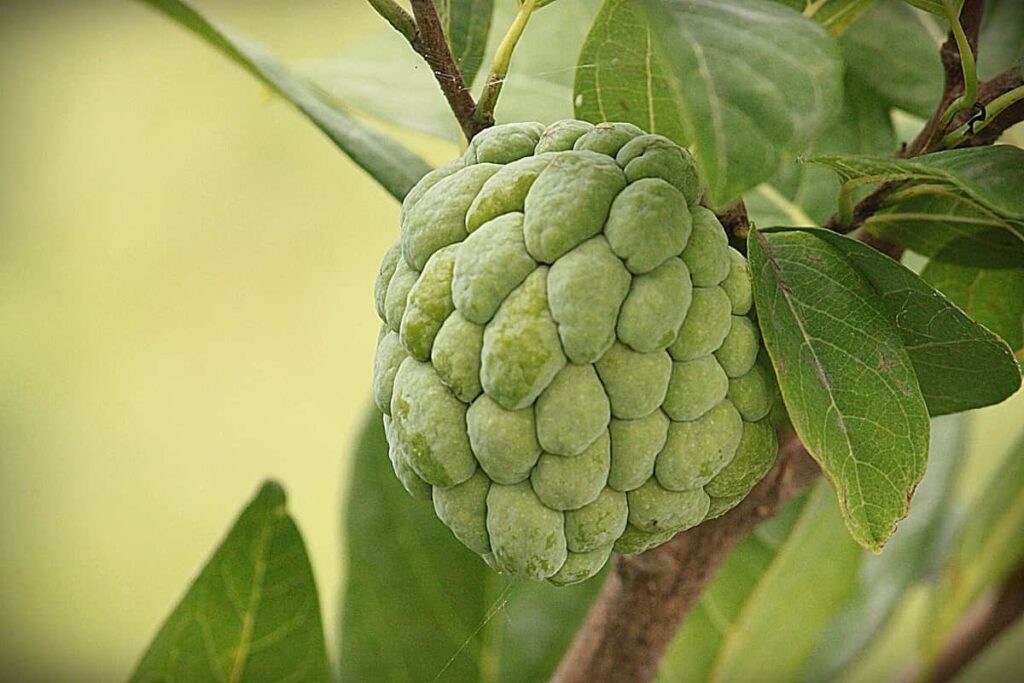
Planting and growing a Custard apple tree in pots or containers
Planting is one of the most critical steps in successfully establishing and growing a robust and productive tree. Choosing a healthy nursery tree is the first step. Custard apple trees are typically grown in nursery containers of three gallons, standing two to four feet from the soil. Small containers should not be used for large trees since the roots may become entangled. Roots with root-bound systems may not grow well when planted in the ground. It is best to grow Custard apple trees in a large container.
Custard apple trees require heavy containers with wider than deep roots to accommodate their shallow roots. It is best to use a half wine barrel with drainage holes for this tree. Look for a drainage hole in the bottom of the container after selecting it. Place the seed in a 1-inch-deep hole in well-drained soil; fill the container with equal quantities of sandy loam and peat. It should be covered with soil. Keep the soil moist by watering it. Make sure you understand the environment well before planting this tree in a container.
Humidity and a windless environment are essential for this plant to thrive. A dry area with relative humidity below 70% should be avoided during the fruit set. Sadly, young Custard apple trees and their fruit are susceptible to frost damage. It is not possible to grow the Custard apple tree inside the house. The container should be placed in an area that receives full sunlight and is protected from the wind. When planting the Custard apple tree in a heated greenhouse, keep an eye on the temperature and use a large fan to cool the greenhouse.
Custard Apple care
Required soil type for growing Custard apple tree
It does not require a specific type of soil. It is possible to cultivate Custard apples in poor, stony soil with a pH level between 7 and 8. Although it can grow in various soil types, from sandy clay to loam, the most productive tree grows in fertile, loose, deep, neutral, or slightly alkaline soil that is not sandy, with good drainage and aeration. In addition, drainage is essential for preventing disease. Growing plants is directly related to soil organic matter content.
Sunlight requirements for growing Custard apple tree
Planting Custard apple trees in full sun will maximize their growth and fruit production. When typical summer rains occur, choose the area of the landscape that is the driest and most warm. Custard apple trees require sunlight of at least 6 hours per day, so plant them in an area of your yard with plenty of sunlight. Choose a landscape area away from trees, buildings, structures, and power lines. Unless pruned, Custard apple trees can reach about 20 feet.
Watering for your Custard apple tree
Extended periods of drought are no problem for this plant. However, excessive drought can result in the loss of leaves and fruits. A rainfall of 750 to 1,200 mm per year is required for optimum growth. It is necessary to stop watering during rainy weather. In general, mature trees should be watered every 12 to 15 days.
Vegetative growth and blooms on new branches will be encouraged by adequate moisture in the soil. Water the tree every 2 to 4 weeks during low growth and every 3 to 5 days during flowering and fruiting. Water stress can be prevented by keeping the soil moist at this time of the year, as the fruit is more sensitive to a lack of water than the leaves.
In case you missed it: How to Grow Cardamom in Pots: Soil, Propagation, Planting, and Care
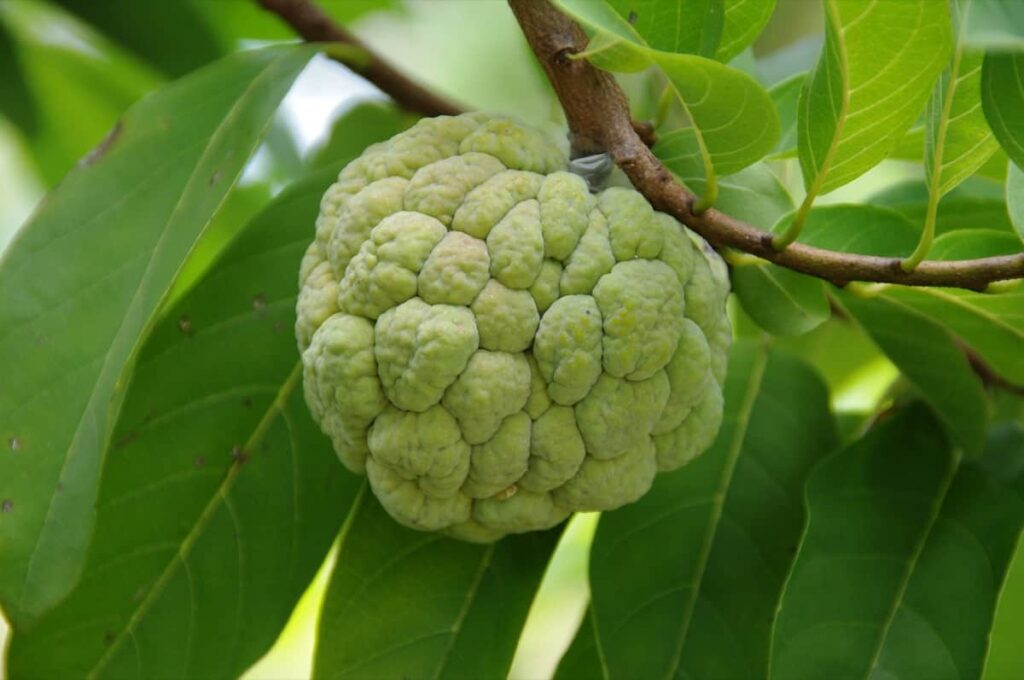
Ideal climate and temperature for growing Custard apple trees
Temperatures between 10°C and 30°C are ideal for growing Custard apple trees. The Custard apple is somewhat resistant to the cold, despite being a tropical tree. Emerging seedlings and young plants will die when the temperature drops below 0°C. Frost tolerance is present in mature trees to some degrees below the freezing point.
Pollination, fruit drop, and post-harvest life are all affected by temperatures above or below optimum. Pollination and flower formation depend highly on relative humidity, a climatic factor. For this reason, it is essential to keep humidity above 60% to increase productivity, especially during the flowering season.
How and when to fertilize your Custard apple
The initial years of planting should be fertilized with a complete fertilizer. 3: 10: 10 fertilizer significantly increases flowering, fruit set, and harvest once the tree reaches maturity. In terms of organic fertilization, the Custard apple responds well to organic matter applied from its earliest growth stages. In addition to improving the texture of the soil and its condition, organic fertilizer facilitates root development. An annual application of 60 to 80 kg of aged manure or compost is recommended.
Water the plants frequently during the growing season when prolonged dry periods occur, and apply nitrogen-containing fertilizer frequently. Trees will bear fruit by the third year so nitrogen-containing fertilizers will be applied less frequently. Approximately 1/4 pound (100 grams) should be applied per tree per application. Gradually increasing the rate as the trees grow is possible. As they grow older, the NPK rates for mature trees should be increased from 1.5 to 4 lbs per tree per application. The number of applications should be two to four per year.
Pruning a Custard apple tree
It would be best if you only pruned in the spring when you live in a cold climate. Custard apple trees develop many branches, so pruning is recommended to control the number of primary branches and train the tree into the desired shape. Maintenance pruning aims to maintain the balance of the tree structure by removing suckers, shoots, and branches that are growing in the wrong direction or pointing down.
After each harvest, it is advisable to perform sanitary pruning. You can remove damaged branches, fruits, pests, and diseases by sanitary pruning. The tree needs to be pruned after about ten years when it becomes older and has less vigor and production. The tree needs to be trimmed firmly in several stages during renewal pruning to restart its growth process.
Mulching for Custard apple tree
There are many types of mulch, including straw, hay, wood chips, and bark chips, which are incompletely degraded organic materials. The mulch around trees reduces the evaporation of moisture from the soil surface. It reduces the need to water as often as with bare soil. Additionally, mulch moderates soil temperatures and eventually degrades into compost. Mulch should be applied 2 to 4 inches thick from the tree’s drip line to within 6 inches of the trunk. Mulch should be kept away from the tree’s trunk to prevent too much moisture from accumulating, which can lead to bark disease.
In case you missed it: How to Grow Poplar Tree: A Guide to Propagation, Planting, and Care
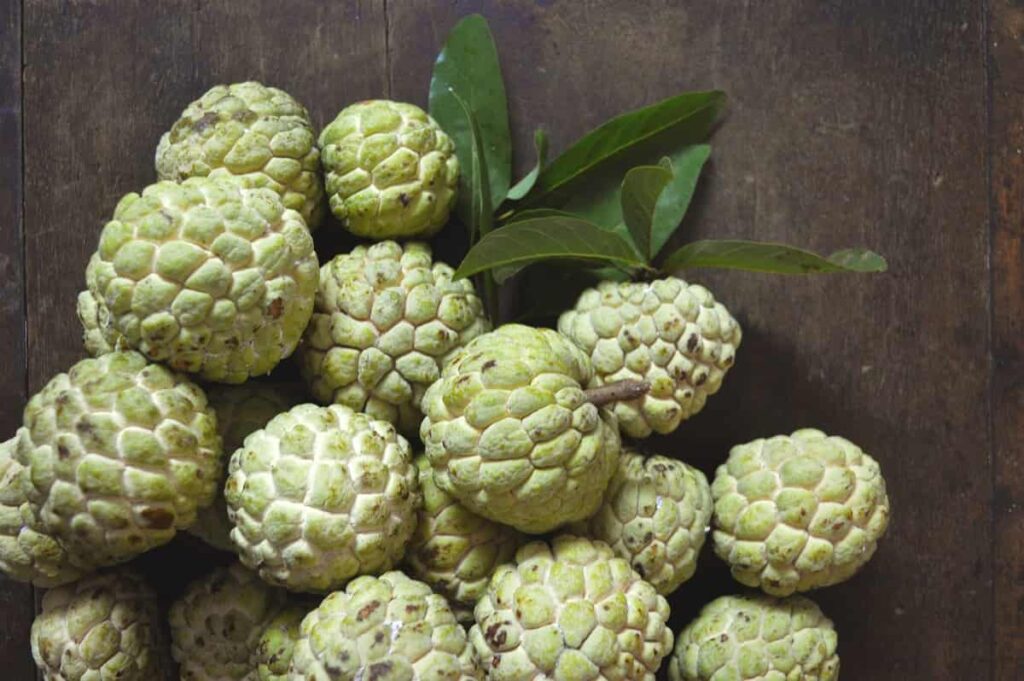
Pests and disease
Pests in Custard apple
Pest | Symptoms | Control method |
Mealy bug | Little bugs usually suck sap from twigs, leaves, and flowers. Infested fruits will have uneven shapes, poor quality, and be susceptible to secondary infections by pathogens. | 1. Collect and destroy the mealy bug-infested leaves, shoots, and fruits.2. Spray dichlorvos 0.05%, twice at new flush and shoot formation and second at fruit set.3. Release Cryptolaemous montrouzieri beetles @ 10/tree. |
Fruit fly | Larvae bore into the semi-ripened fruits and feed on the pulp.Affected fruits become shriveled, deformed, rot and drop. | 1. Collect fallen-infested fruits and dispose of them by dumping in a pit and covering them with soil.2. Use bait spray combing any insecticides and molasses or jaggery at 10 g/l,a. Fenthion 100 EC 1ml/lb. Malathion 50 EC 2 ml/l |
Scales | The insertion of stylets causes direct damage during feeding by the nymphs, which causes premature leaf drop and drying of twigs. Sooty mold develops on honeydew excreted by these scale insects, and in case of severe infestations, shoots or branches die, and the host’s death may also occur. | The regular release of Cryptolaemus Montrouzier Australian native beetle larvae. Aphytis wasp release controls armored scale with the regular release of green lacewings |
| Fruit boring caterpillar | Caterpillar makes irregular tunnels and damages the mesocarp by feeding the internal content of the fruits. The presence of excreta of the caterpillars near the entry holes on the affected fruits. The growth of affected fruits is arrested and later falls. | 1. Collect and destroy the damaged fruits2. Spray endosulfan 0.07% or malathion 0.1% two times, once at flower formation and second at fruit set |
In case you missed it: How to Grow African Violets: A Guide to Propagation, Planting, and Care
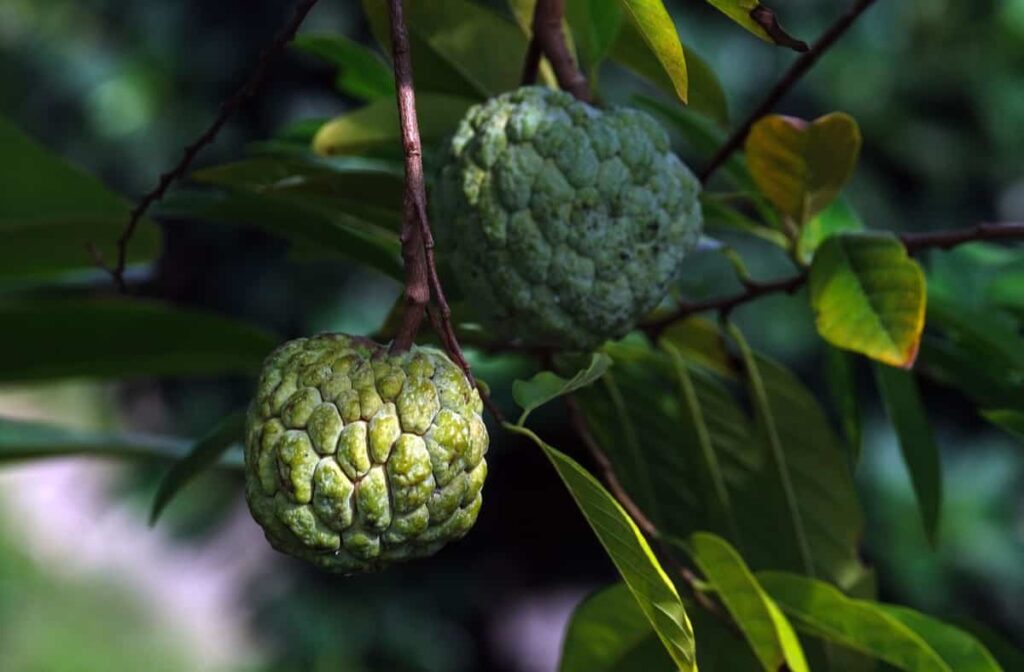
Diseases in a Custard apple tree
Disease | Symptoms | Control method |
Anthracnose | Affected fruits fade, and they will cling to the tree or fall.Necrotic patches of 2 to10 mm in diameter on unripe fruits change later into dark brown to black spots. | 1. Remove and destroy infected plants in the garden. For trees, prune out the dead wood and discard the infected leaves.2. Spraying the plants with a copper-based fungicide |
Leaf spot | Small yellowish spots first appear along the leaf margins, gradually growing into brownish patches with concentric rings. The severe infection leads to drying and defoliation. Dark brown-purplish patches appear on the infected fruits below their attachment to the shoots. | 1. Collect and burn the infected plant parts to minimize thespread of the disease.2. Increase air circulation through proper pruning. |
Harvesting Custard apples
Custard apple trees begin to bear fruit at 3 to 4 years old and decline after 12 to 15 years. Between 100 and 180 fruits are produced by an average adult tree every year. Choosing the optimal harvest time is crucial. Also, all fruits do not ripen simultaneously, and the collection time varies, depending on the variety and weather conditions where they are grown. The standard method is to look at the discoloration of the skin and shape to determine when to harvest fruit,
A third indication of ripening is the change in color of seeds, which turn almost black when ripe. These criteria are generally unreliable in indicating proper maturity; sometimes, fruits are harvested before they ripen. It is for this reason that commercial producers use chemical ripeners post-harvest. Pruning shears must be used to cut the stems of fruits. Harvesting should also be done in the morning. Care should be taken when harvesting the Custard apple fruit.
Conclusion
Custard apple trees bloom between March and June, and fruit is harvested between mid-summer and fall. The fruit may be available through midwinter if there is no frost and the leaves remain on the trees. Climate, the presence or absence of natural pollinators, disease, insect pressures, and cultural practices will influence Custard apple crop yields.
- Aquaponic Farming at Home: A Step-By-Step Guide
- Profitable Village Farming Business Ideas in 2024
- High-Yield Aquaculture: Fast-Growing Fish for Farming
- Effective Fish Pond Construction Techniques for Beginners
- Irrigation and Water Management in Pineapple Farming
- Blossom to Harvest: Mastering Flowering and Pollination in Papaya Farming
- Pig Fattening Essentials: From Selection to Sale for Beginners
- Raising Wagyu Cattle: A Complete Guide for Premium Beef Production
- Soil Types and Their Water Holding Capacity
- Optimizing Irrigation Schedules for Coconut Groves for Enhanced Yield
- Espresso Your Garden: Coffee Grounds for Healthier Acid-Loving Plants
- The Best Soil Mix for Snake Plants: How to Mix Your Own Snake Plant Soil
- Green Thumb Success: Expert Tips for Cultivating Greenhouse Beans All Year Round
- Bloom All Year Round: The Ultimate Guide to Indoor Hyacinth Care
- Eco-Friendly Gardening: How to Make Liquid Fertilizer from Kitchen Waste
- Ultimate Guide to Grow Anise in Pots: Explore Seed Propagation to Harvesting
- Guide to Raising Chester White Pigs: Discover Breed Facts to Growth Management
- Mastering the Elegance: The Ultimate Guide to Weeping Cherry Tree Care, Planting, and Maintenance
- Ultimate Guide to Planting Garlic in Grow Bags: Growing Strategies for Beginners
- How to Fix Spider Plant Leaf-Related Problems: Natural and Organic Remedies
- 10 Reasons Why Your Tulsi Plant is Shedding Leaves: Home Remedies and Solutions
- Optimizing Growth and Yield: The Advantages of Palm Bunch Ash Fertilizer
- Utilizing Neem Oil Extract as a Natural Pesticide for Hydrangea
- From Soil to Harvest: Various Ways in Which Farmers Can Use AI Tools
- Steps to Encourage and Induce Citrus Flowers: A Comprehensive Guide
- How to Fix Snake Plant Leaf-Related Issues: Natural and Organic Remedies
- Transform Your Garden into a Fragrant Oasis with Raat Ki Rani (Night Blooming Jasmine)
- Discover the Ideal Chicken Breeds for Philippine Farms
- How to Create a Poultry Egg Farm Business Plan for Profits
- Grow Lemon Cucumbers Like a Pro: Insider Techniques for Bountiful Yields
- Ultimate Guide to Caring for Your Pink Princess Philodendron: Tips for Thriving Variegation
- Areca Nut Profit Per Acre: Calculating Yield and Cost of Cultivation
- How Kaveri Chicken is Becoming a More Profitable Breed in Indian Backyards
- Transform Your Barn: 9 Steps to Convert a Horse Stall into a Chicken Coop
- Exploring Suffolk Sheep Disadvantages with Limitations and Challenges
- Guide to Solving Potted Lemon Tree Problems: How to Revive Lemon Tree in Containers
